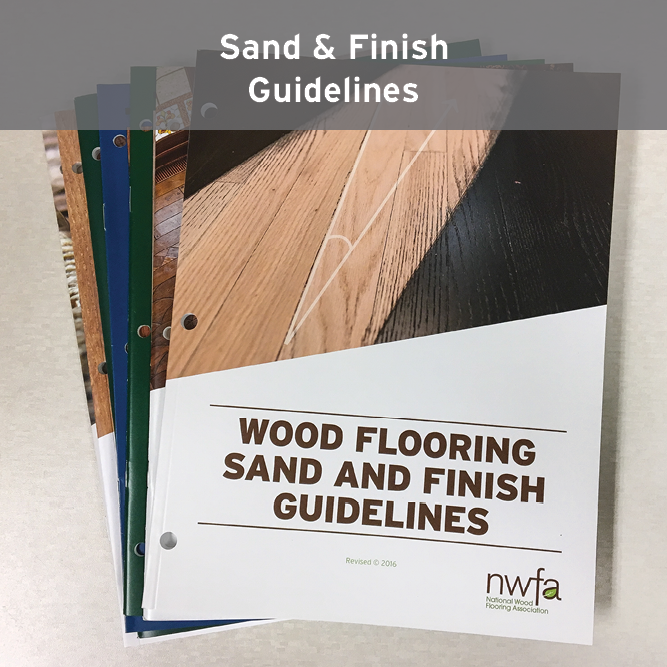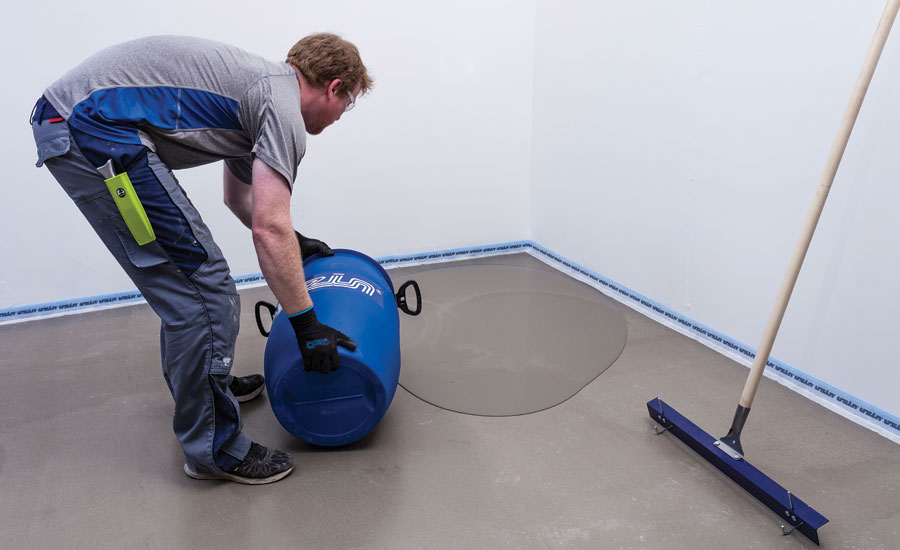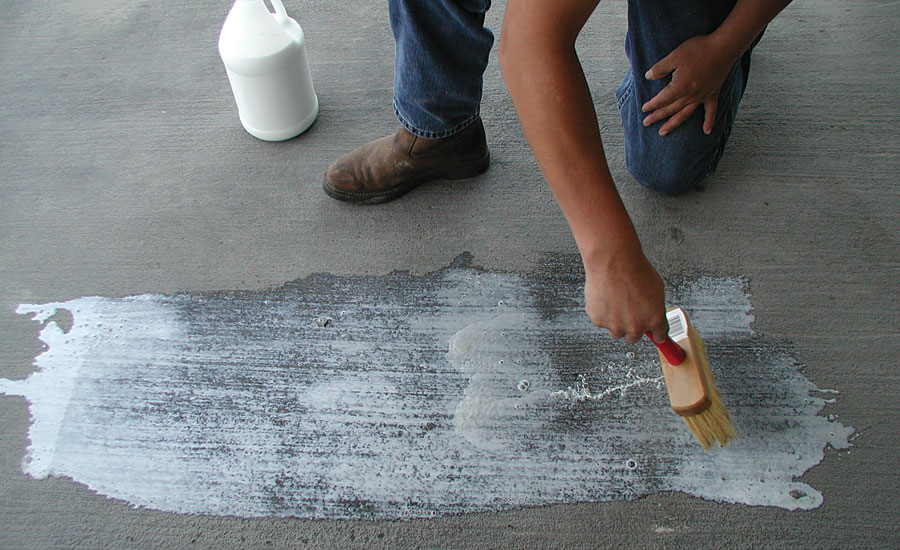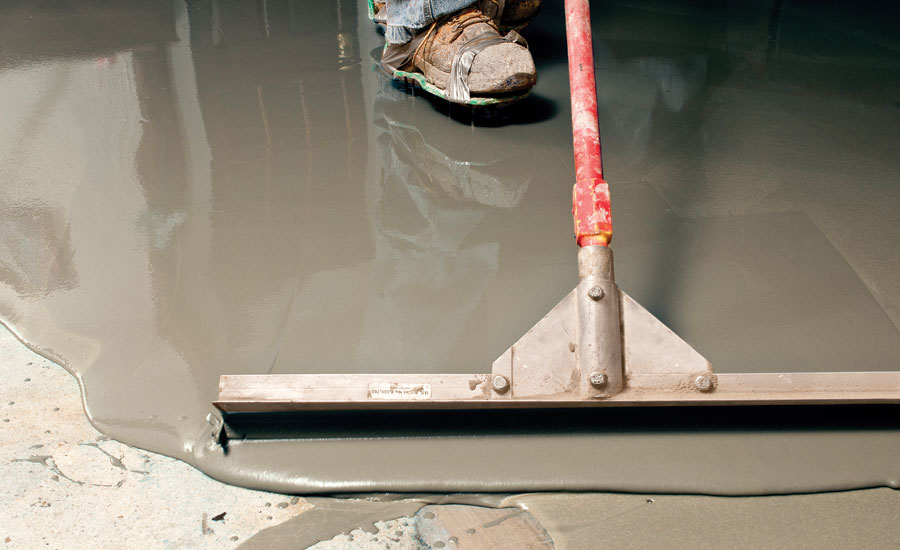Self-Leveling Underlayments: Tips, Techniques and Tools

Most SLUs demand an accurate mix of powdered product and water, which create a flowable liquid. If too much water is used or the product is overmixed, clumps and inconsistencies will appear. Photo courtesy of UFLOOR Systems, Inc.

Before applying a self-leveling underlayment (SLU) to a floor, most require a primer beforehand to prep the initial surface. Photo courtesy of Texrite.

There are many tools that can be used to apply a self-leveler, including wide rakes, smoothers, trowels and spike rollers. Photo courtesy of Bostik.

Some larger manufacturers prefer introducing a “family” of SLUs when unveiling new products, such as MAPEI, which recently released its trio of Ultraplan products. Photo courtesy of MAPEI.




In the following article, we will consider the advantages of using self-leveling underlayments, feedback from contractors and installers and the products available on the market.
Self-leveling underlayments (SLUs) have become increasingly popular as the degree of flatness and smoothness required for floor covering products has increased. We recently got the chance to gather some advice from industry manufacturers about the importance of SLUs, including their benefits and usage, which revealed some interesting facts about the prominent products.
Exploring SLUs
Technically, the term “self-leveling” was coined in the U.S. by Ardex, in 1978 in reference to their first self-leveling product, Ardex K 15 Premium Self-Leveling Concrete Underlayment. The term was used to differentiate it from traditional concrete, which is typically stiffer and requires more labor to get it into place and finish with a trowel.
“Self-levelers provide a flatter, higher quality substrate, resulting in a better performing finished floor,” stated Greg Hunsicker, category business manager of flooring & finishing segments at Ardex Americas. “In addition, self-levelers keep installers off of their knees and reduce the amount of labor required to provide a flat, smooth substrate.”
“Self-leveling underlayments offer two primary advantages over traditional underlayments,” explained Alex Keene, division manager at Dependable, LLC, in Rocky River, Ohio. “The first advantage is speed, allowing an installer to level a large area without using significant amounts of time and labor to accomplish the task. The second advantage is superior leveling. Unlike patches, which are more highly prone to human error, a good self-leveling underlayment will level itself without human assistance.”
Alan Kin, head of technical sales at Texrite in Houston, echoed Keene’s and Hunsicker’s thoughts. “There is a definite reduction in labor and skill effort to achieve a much flatter floor surface,” he said. “The ability to pour and apply thin to thick flowable layers on different surfaces is unparalleled.”
Since many companies offer comparable products, distinguishing a brand is very important in the market nowadays. “Our ultimate goal is to offer industry partners a better understanding of how to select the very best system for every installation they embark upon,” said Chad Bulen, technical services manager for Bostik’s Consumer & Construction Business Unit, who explained how the company offers training for its products in designated centers throughout Texas, California and Wisconsin.
“We provide additional resources through our responsive and knowledgeable Technical Services support staff and helpful technical guideline documents,” added Christopher Brana, product manager for Laticrete’s NXT. “Laticrete continues its commitment to innovation and delivering superior quality products and service to customers.”
“A world without alternatives can be extremely limiting,” explained Jeffrey Johnson, business manager for MAPEI’s Floor Covering Installation Systems line. “That is why, in North America, MAPEI’s Floor Covering Installation Systems products include 10 distinct self-leveling underlayments and six primer solutions, with even more choices coming on the horizon. Each of these levelers offers unique handling and performance attributes designed to meet most subfloor preparation challenges.”
While most SLUs require a primer before they’re installed, additional tools are also helpful. “The use of pumps, mixing barrels, leveling compound rakes, gauge rakes, smoothers and spike rollers are the common tools used in effective leveling compound placement,” said Kirk Francis, marketing director for UFloor Systems, Inc. in Aurora, Colo.
“Additional tools can be added to aid applications, such as a heavy-duty handled bucket, long-poled handle spreader, or long-poled handled smoother/finishing blade trowel for reach over large areas,” added Kin. “The use of spiked/cleated shoes can be worn to allow the ability to walk into wet, liquid state mortar; spiked shoes become more critical when leveling the entire room’s floor or very large areas. On very large application jobsites—such as a factory, warehouse or institution floor—continuous pumping and mixing equipment and a hose can be used.
“Also, use open loop mixing with a wand or paddle, clean pail and 1/2 inch heavy duty mixing drill,” he went on to explain. “Smaller capacity or non-heavy duty drills will burn out or become damaged from mixing the liquefied product.”
Feedback is vital
Aside from the obvious benefits of SLUs, they also provide ease of mind when applied properly, helping ensure the life of any floor installation. Many companies thrive off of the feedback from its customers, who are the professionals that aid in the development of newer, innovative products.
“Contractors can become frustrated when they have not been completely trained or are unfamiliar with the systems, especially if they are on a jobsite,” explained Bulen. “Once they have chosen the right system for the installation type, know the correct technique and have the right tools, they can experience phenomenal success in less time and with less money.”
“Once they have chosen the right system for the installation type, know the correct technique and have the right tools, they can experience phenomenal success in less time and with less money.”
– Chad Bulen
“Not all leveling compounds are the same,” noted Francis. “Uzin has pioneered new product technology that is based on strong relationships with our contractor customers. Our product development model includes a requirements-based discovery process that incorporates a high level of input from the installer and contractor business owner.
“What has resulted from that close relationship with customers is something we call the ‘Level Plus + Effect’ that is built into a number of our leveling compounds. These products feature high fluidity, excellent absorbency, superior surface smoothness, increased dimensional stability and fast hardening/curing. Our levelers also have an ‘in-spec’ water range for greater project flexibility.”
“All three of our new products were developed based on installer feedback and have had outstanding customer response since their launch,” added Hunsicker.
“Positive and negative reactions can be experienced,” explained Kin. “Positive experiences are users overcoming the initial material cost of self-leveling and viewing a newer, flatter and faster floor leveling as a total construction cost savings (manpower, labor and overall sweat equity).
“The negatives experienced by installers occur from ‘estimation/over-watering in mixing,’ since the self-leveling underlayment mix ratio is extremely water specific. Overwatering produces underlayment shrinkage, spalling, cracking and delamination in self-leveling products. Careful, exact water measurement is vital to the success of an installation; remember that different manufacturers have different weights in bags and water demands in mixing ratios. The more fluid nature of pourable, self-leveling underlayments requires a tighter, clean bond to surface. Failure to properly and fully remove bond contaminants and/or not using the required primers will induce delamination or failure of the underlayment to remain bonded.
“If self-leveling underlayments are not measured and excess water is introduced, then an inconsistent, non-uniform surface and top color change can be observed,” Kin went on to say. “Any unusual bubbling, pinholes and/or color swirls in the underlayment finish are visual indicators of non-use of the primer or overwatering/excess water addition at mixing. Although easier to pour, screed out and fill low areas of floor, these products do require close attention of mixing and bond surface preparation. Those that follow the clean bond surface, primer usage and measured mix water are rewarded with an easy, poured and flat finished floor.”
New products on the market
When developing new products, some companies work on a product-by-product basis, introducing single products as they’re created, while others like to unveil an entire line that includes various working parts, such as MAPEI.
“Three of our latest self-leveling underlayments offer unique performance characteristics not usually found in our primary product portfolio,” said Johnson. “The products are Ultraplan LSC, a high-flow, liquid skimcoat and self-leveling underlayment; Ultraplan Lite, a low-density self-leveling underlayment; and Ultraplan QuickTraffic, a quick-setting, early-installation self-leveling underlayment. MAPEI is dedicated to providing as many menu selections for self-leveling as there are conditions to prepare, and our R&D staff continues to work on even more choices.”
Several other companies have also recently introduced a “family” of SLUs, which feature new technology and support a personalized concept or idea for companies to further differentiate their products.
“Ardex has recently launched new self-leveling products, which each provide unique technologies to the market supporting our ‘Choose Your Solution’ concept,” said Hunsicker, who described the company’s trio of new products, including Ardex K 22 F, a fiber reinforced high-flow SLU; Ardex K 10, a “reactivatable” high-flow SLU, designed for leveling at 1/8 inch; and Ardex K 60, a two-component (powder and liquid) SLU that needs little to no preparation or priming.
“Laticrete is proud to offer a family of self-leveling products called NXT,” added Brana. “NXT substrate preparation products have been formulated using state-of-the-art technology and provide world-class performance for a variety of applications including self-leveling underlayments, patching, skimcoat, priming and moisture mitigation. We offer guidelines for ensuring that the substrate is properly prepared and primed prior to installation of these self-leveling products.”
“Texrite has Flowrite 250 and Flowrite 250 fs with Bonding Primer 500 as a pourable, self-leveling underlayment system for eliminating unwanted sloped, unevenly pitched and depressed or rough/scarred floors from zero- to one-inch thickness in single applications,” said Kin. “Both Flowrite 250 and Flowrite 250 fs allow light, walk-on traffic within the same day of application; however, the Flowrite 250 fs is a fast-setting and curing version that can accommodate quicker walk-on traffic within four to six hours after wet-poured application.”
Although some companies take the approach of introducing several products simultaneously, others find it beneficial to introduce new products one at a time. “Our flagship product, Uzin NC 170 Levelstar Premium Self Leveling Compound, is one of these newer, innovative leveling compounds that addresses the needs and requirements of professional flooring contractors for today’s commercial flooring projects.” said Francis.
“SL-200 is an ultra-fluid, self-smoothing underlayment used in preparation of finished floor coverings,” explained Bulen. “It can be installed at 1/8 inch using a gauge rake and smoothing tool. The ultra-fluid, single lift application increases production over multi-coat patching methods and leaves a smoother surface. SL-200 can also be installed as a self-leveling underlayment up to one inch when a flat or level subfloor is desired. This breakthrough formulation can be easily installed by one person, working alone, due to its long open time and superior flow rate.”
“Dependable launched its newest self-leveling underlayment in winter 2015, called Skimflow HPI. Skimflow HPI replaced our Skimflow HP product, and fills a significant niche in the market to cover flexible substrates and substrates requiring low shrinkage products,” said Keene. “Unlike traditional cementitious underlayments, Skimflow HPI requires no mechanical preparation and offers a safe alternative to shrinking cements. It is pumpable and pourable, offering an installer the flexibility to either barrel mix or pump the product when needed. After cleaning the floor, a primer is required to ensure a durable bond. When necessary, seal the floor using a latex product. In thin pours, flooring can be installed the next day.”
This is by no means a complete list of companies that offer SLUs or a comprehensive overview of all products. When determining the proper SLU to use, it all comes down to selecting the right product for the right job, from a company you can trust.
“Proper substrate evaluation, assessment and preparation, as well as knowing the flooring materials that will be used, are the critical first steps taken prior to determining and selecting the appropriate product systems, including leveling compounds that will be used on the project,” said Francis.
Looking for a reprint of this article?
From high-res PDFs to custom plaques, order your copy today!












